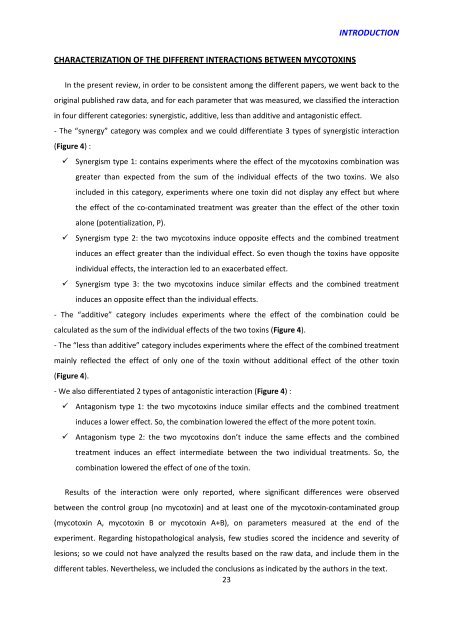Effet chez le porcelet d'une exposition à un régime co-contaminé en ...
Effet chez le porcelet d'une exposition à un régime co-contaminé en ...
Effet chez le porcelet d'une exposition à un régime co-contaminé en ...
You also want an ePaper? Increase the reach of your titles
YUMPU automatically turns print PDFs into web optimized ePapers that Google loves.
INTRODUCTIONCHARACTERIZATION OF THE DIFFERENT INTERACTIONS BETWEEN MYCOTOXINSIn the pres<strong>en</strong>t review, in order to be <strong>co</strong>nsist<strong>en</strong>t among the differ<strong>en</strong>t papers, we w<strong>en</strong>t back to theoriginal published raw data, and for each parameter that was measured, we classified the interactionin four differ<strong>en</strong>t categories: synergistic, additive, <strong>le</strong>ss than additive and antagonistic effect.- The “synergy” category was <strong>co</strong>mp<strong>le</strong>x and we <strong>co</strong>uld differ<strong>en</strong>tiate 3 types of synergistic interaction(Figure 4) : Synergism type 1: <strong>co</strong>ntains experim<strong>en</strong>ts where the effect of the my<strong>co</strong>toxins <strong>co</strong>mbination wasgreater than expected from the sum of the individual effects of the two toxins. We alsoincluded in this category, experim<strong>en</strong>ts where one toxin did not display any effect but wherethe effect of the <strong>co</strong>-<strong>co</strong>ntaminated treatm<strong>en</strong>t was greater than the effect of the other toxinalone (pot<strong>en</strong>tialization, P). Synergism type 2: the two my<strong>co</strong>toxins induce opposite effects and the <strong>co</strong>mbined treatm<strong>en</strong>tinduces an effect greater than the individual effect. So ev<strong>en</strong> though the toxins have oppositeindividual effects, the interaction <strong>le</strong>d to an exacerbated effect. Synergism type 3: the two my<strong>co</strong>toxins induce similar effects and the <strong>co</strong>mbined treatm<strong>en</strong>tinduces an opposite effect than the individual effects.- The “additive” category includes experim<strong>en</strong>ts where the effect of the <strong>co</strong>mbination <strong>co</strong>uld becalculated as the sum of the individual effects of the two toxins (Figure 4).- The “<strong>le</strong>ss than additive” category includes experim<strong>en</strong>ts where the effect of the <strong>co</strong>mbined treatm<strong>en</strong>tmainly ref<strong>le</strong>cted the effect of only one of the toxin without additional effect of the other toxin(Figure 4).- We also differ<strong>en</strong>tiated 2 types of antagonistic interaction (Figure 4) : Antagonism type 1: the two my<strong>co</strong>toxins induce similar effects and the <strong>co</strong>mbined treatm<strong>en</strong>tinduces a lower effect. So, the <strong>co</strong>mbination lowered the effect of the more pot<strong>en</strong>t toxin. Antagonism type 2: the two my<strong>co</strong>toxins don’t induce the same effects and the <strong>co</strong>mbinedtreatm<strong>en</strong>t induces an effect intermediate betwe<strong>en</strong> the two individual treatm<strong>en</strong>ts. So, the<strong>co</strong>mbination lowered the effect of one of the toxin.Results of the interaction were only reported, where significant differ<strong>en</strong>ces were observedbetwe<strong>en</strong> the <strong>co</strong>ntrol group (no my<strong>co</strong>toxin) and at <strong>le</strong>ast one of the my<strong>co</strong>toxin-<strong>co</strong>ntaminated group(my<strong>co</strong>toxin A, my<strong>co</strong>toxin B or my<strong>co</strong>toxin A+B), on parameters measured at the <strong>en</strong>d of theexperim<strong>en</strong>t. Regarding histopathological analysis, few studies s<strong>co</strong>red the incid<strong>en</strong>ce and severity of<strong>le</strong>sions; so we <strong>co</strong>uld not have analyzed the results based on the raw data, and include them in thediffer<strong>en</strong>t tab<strong>le</strong>s. Neverthe<strong>le</strong>ss, we included the <strong>co</strong>nclusions as indicated by the authors in the text.23

















